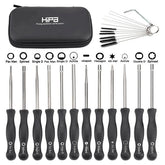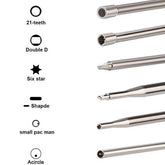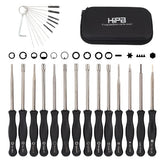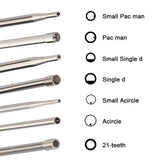How To Maintaining or Tune-up Your Chainsaw Properly at Different Period
The chainsaw operates at high speed. For instance, a 3/8-inch chainsaw chain with a sprocket tooth count of 7 teeth and an engine speed of 7000 revolutions per minute has a running speed of approximately 15.56 meters per second. The driving force of the sprocket and the reaction force during cutting are concentrated on the rivet axis. Due to harsh working conditions and severe wear, the chainsaw chain can quickly become unusable if not adequately maintained.
To ensure normal operation and extend its lifespan, maintenance should be carried out in several aspects:
01 Daily Maintenance:
- Clean the air filter and check for any damage. Replace if necessary.
- Rotate the guide plate before each use to ensure even wear. Check if the guide plate oil groove is blocked and clean it.
- Check the oil pump and regularly add lubricating oil to ensure sufficient lubrication of the guide plate and chain. Check if the throttle lever operates smoothly (if it is not flexible or if the engine idle is not smooth, it should be sent to the dealer for repair).
- Maintain the sharpness of the cutting edge and the symmetry of the left and right cutting teeth.
- Regularly adjust the tension of the chainsaw chain; it should not be too tight or too loose. A properly adjusted chainsaw chain should have a middle pin fully exposed in the guide plate groove when pulling the chain up by hand.
- Clean the dirt from the guide plate groove and chainsaw chain promptly. During cutting, both the guide plate and chainsaw chain will wear, and the iron shavings and fine sand produced from the wear will accelerate the wear. Resin on trees, especially grease on pine trees, will melt and adhere to the chainsaw chain during cutting, sealing and hardening the joints, preventing the entry of oil and lubrication, and accelerating wear. It is best to remove the chainsaw chain and soak it in kerosene for cleaning after use.
- Maintenance of the chainsaw chain: Properly maintained and sharpened chainsaw chains only require minimal pressure to easily cut into wood. During routine maintenance, check if there are cracks or broken rivets on the chain links. Replace any damaged or worn parts on the chainsaw chain, then match them with new parts of the same shape and size. Carbide chains are particularly wear-resistant. When using a new chainsaw, pay attention to the tightness of the chainsaw chain. It should be able to rotate when pushed, and when manually lifting the chainsaw chain, the depth gauge should be parallel to the guide plate. After a few minutes of use, check the tension of the chainsaw chain again.
02 Weekly Maintenance:
- Check if the shock absorption components have aged or worn out.
- Clean the spark plug and check the electrode gap. The normal gap should be 0.5mm.
- Check the starter and recoil spring.
- Clean the cylinder cooling fins.
- Clean the filter on the chainsaw muffler.
- Clean the carburetor housing and air intake chamber.
03 Monthly Maintenance:
- Check if the clutch is severely worn. Replace it in a timely manner if necessary.
- Clean the carburetor.
- Check the fuel filter. Replace it if necessary.
- Check the pipeline joints.
- Check if the muffler is loose, damaged, or corroded.
04 Long-Term Storage:
- Drain the remaining mixed fuel and start the engine to burn off the residual mixed fuel until it automatically shuts down. Keep running the engine before the carburetor dries to prevent the diaphragm from sticking together. Remove the chainsaw chain and guide plate, clean them, and then spray them with rust-proof oil. Thoroughly clean the machine, especially the cylinder cooling fins and air filter. Check for any damage or loose screws.
- After using the chainsaw, if it needs to be stored, clean the body, drain the mixed fuel, and burn off the fuel in the carburetor. Remove the spark plug, add 1-2ml of two-stroke engine oil into the cylinder, pull the starter 2-3 times, and then reinstall the spark plug, fixing it in the compressed position.
- Apply rust-proof oil to metal parts such as the fuel line. Finally, store the chainsaw in a moisture-free indoor area after installing the blade guard.
05 Maintenance of the Chainsaw Engine:
The chainsaw is fitted with a two-stroke engine. Attention should be paid to the power and cutting tools to ensure the machine's normal operation. The engine uses a mixture of gasoline and oil, and the recommended fuel mixture ratio is: two-stroke specialized engine oil to gasoline = 1:50 (ordinary engine oil to gasoline = 1:25). Use gasoline with a rating of 90 or higher and use two-stroke engine oil labeled as 2T. It is strictly prohibited to use four-stroke engine oil. Mix the fuel at a ratio of 1:40 (ordinary engine oil 1:20) for the first 30 hours of a new machine, then switch to the normal ratio of 1:50 (ordinary engine oil 1:25) after 30 hours. Do not exceed the ratio of 1:50 (ordinary engine oil 1:25), as a concentration too thin can cause the cylinder to seize. Strictly follow the oil mixing ratio provided with the machine and avoid using mixed fuel that has been stored for a long time. Before operating the machine, run it at low speed for a few minutes to ensure that the chainsaw chain is lubricated with oil and forms an oil line before starting normal operation. During operation, keep the throttle on high speed. Rest for 10 minutes after using up a tank of fuel and clean the machine's gaskets to ensure proper heat dissipation. Remove the spark plug every 25 hours of use and use a wire brush to remove dust from the electrodes. Adjust the electrode gap to 0.6-0.7mm. Clean the air filter every 25 hours. If there is a large amount of dust, it should be replaced more frequently. Clean the foam filter with gasoline or detergent and water, squeeze it dry, then soak it in engine oil. Squeeze out the excess oil before installation. If it is labeled "DO NOT OIL," do not add oil. Every 50 hours of use, remove the muffler and clean the carbon deposits on the exhaust port and muffler outlet. Remove impurities from the fuel filter (fuel suction head) every 25 hours.
06 Improper Maintenance May Lead To:
- Cylinder seizure:
- Insufficient lubrication leading to cylinder seizure.
- Foreign objects entering the cylinder causing cylinder seizure.
- Difficulty starting the machine:
- Difficulty starting due to carbon deposits on the spark plug electrodes.
- Difficulty starting due to incorrect carburetor adjustment.
In conclusion, maintenance is crucial to ensure a chainsaw's proper functioning, enhance safety, and extend its lifespan. Regular inspections, cleaning, and maintenance help detect and resolve issues, keeping the chainsaw in optimal condition.
Product Recommendation
1. HIPA Air System Maintenance Kit
What is the Hipa Maintenance kit? Hipa Maintenance Kit includes an air filter, fuel filter, oil filter, and spark plug. Include everything you need to replace your degraded air fuel system, all fit perfect. It provides a wonderful solution for homeowners to maintain or tune-up their gas-powered chainsaw.






















1 comment